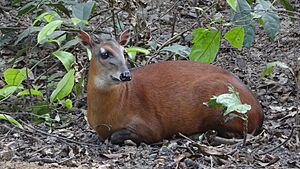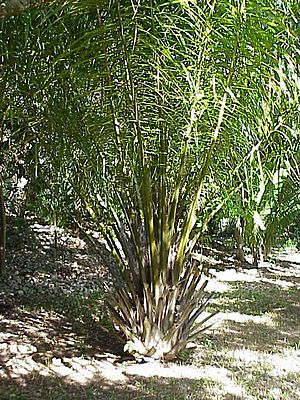Bay duiker facts for kids
Quick facts for kids Bay duiker |
|
|---|---|
 |
|
| Individual in Gabon | |
| Conservation status | |
| Scientific classification | |
| Subspecies | |
|
The bay duiker (Cephalophus dorsalis) is a small antelope that lives in forests. It's also called the black-striped duiker or black-backed duiker. You can find it in western and southern Africa. A British zoologist named John Edward Gray first described it in 1846. There are two types, or subspecies, of bay duikers.
Bay duikers are reddish-brown and have a medium size. Both males and females are about 44 to 49 centimeters (17 to 19 inches) tall at the shoulder. They weigh around 18 to 23 kilograms (40 to 50 pounds). Both sexes have short, spiky horns that are about 5 to 8 centimeters (2 to 3 inches) long. A cool thing about this duiker is the clear black stripe. It runs all the way from the back of its head to its tail.
Bay duikers are mostly active at night. They usually live alone, but sometimes you might see them in pairs. The leopard is their main predator. These duikers love to eat fruits. But they might also eat small animal things, like bird eggs. Female duikers can have babies when they are about 18 months old. They can breed all year round. A baby duiker is born after about 240 days. Usually, only one baby is born at a time. Bay duikers typically live for 17 to 18 years.
Bay duikers prefer to live in very old, untouched forests. Sadly, people have hunted them a lot for their meat. Their homes are also shrinking because of human settlements and farms. This is a problem because they need those old forests. Even with these threats, the bay duiker is still a common type of duiker. It is listed as near threatened by the IUCN. This means it might become endangered in the future.
Contents
About the Bay Duiker
What's in a Name?
The bay duiker was first described by John Edward Gray in 1846. The name Cephalophus probably comes from two old words. Cephal is a New Latin word for "head." Lophos is a Greek word for "crest." This refers to the tuft of hair on their heads. The second part of its scientific name, dorsalis, is a Latin word. It means "of the back," pointing to the stripe on its back.
The common name "duiker" comes from the Afrikaans or Dutch word duik. Both words mean "diver." This name fits because these antelopes often "dive" into bushes to hide. The bay duiker is also known as the black-striped duiker or black-backed duiker.
Family Tree
Scientists study how animals are related to each other. They have found that the bay duiker is part of a group called "giant duikers." This group includes the yellow-backed duiker, Abbott's duiker, and Jentink's duiker. The zebra duiker is also a close relative.
|
||||||||||||||||||||||||||||||||||||
| How bay duikers are related to other duikers (Johnston et.al. 2012) |
There are two main types of bay duikers:
- C. d. dorsalis (Gray, 1846): This is the western bay duiker. It lives in western Africa.
- C. d. castaneus (Thomas, 1892): This is the eastern bay duiker. It lives in central Africa.
Appearance of the Bay Duiker
The bay duiker is a medium-sized antelope. Its body, from head to tail, is about 76 to 103 centimeters (30 to 41 inches) long. Both males and females stand about 44 to 49 centimeters (17 to 19 inches) tall at the shoulder. Their weight is usually between 18 and 23 kilograms (40 and 50 pounds). Females are often a bit bigger than males.
Their tail is about 9 to 11 centimeters (3.5 to 4.3 inches) long. It is black on the outside and white inside. The eastern bay duiker has a white tuft of fur at the end of its tail. Both males and females have spiky horns. These horns are typically 5 to 8 centimeters (2 to 3 inches) long. Female horns are usually thinner.
Both male and female bay duikers have a bright reddish-brown coat. Their belly and sides are also reddish-brown. Their legs are dark brown. A very noticeable feature is the strong black stripe. It runs from the back of their head all the way to their tail. This stripe is thinner on females.
Because they are active at night, bay duikers have large, noticeable eyes. They also have whiskers above their eyes and around their nose. White fur patches around the whiskers stand out against their dark reddish face. Young duikers have a dark coat. They slowly get their stripes and reddish-brown color as they grow. Their head has a small tuft of dark brown hair. The eastern bay duiker is larger and heavier. It also has bigger ears and a darker coat. Its black stripe is wider and lighter in color.
Bay duikers look similar to some other duikers. For example, the red duiker is hard to tell apart. The Ogilby's duiker is similar in size and color. However, its belly is paler, and its black stripe starts from its shoulders, not its head. The bay duiker is also very much like the black duiker, but their fur colors are different.
Life in the Forest
Daily Habits
The bay duiker is a nocturnal animal. This means it is active at night. Because of this, we don't know a lot about its daily habits. During the day, the bay duiker rests. It might lean against trees or hide in thick bushes. They usually live alone, but sometimes you can see them in pairs.
Bay duikers are very alert and aware of their surroundings. They use their strong sense of smell a lot. This helps them find food and spot danger. They communicate with each other using scents from glands near their eyes. They also use their droppings to leave messages. The leopard is the main animal that hunts bay duikers. Eagles, bonobos, and mandrills might also hunt them. If a duiker feels scared, it will freeze. Then it might suddenly leap away to escape.
What They Eat

Bay duikers mainly eat fruits. They especially like large fruits from trees like wild mango and oil palms. They also eat orange fruits, olive-like fruits, and green plums. They even eat fruits that look like cocoa pods. The duiker will chew the pulp from the seeds. If the seeds are big, they spit them out. Smaller seeds, like those from Antrocaryon trees, might be swallowed.
Sometimes, bay duikers also eat other things. They have been seen eating birds (but not their legs or wings). They might also eat unhatched bird eggs, dead animals, or even insects like termites and beetles. In captivity, they can eat dog food as a treat.
Having Babies
Female bay duikers can start having babies when they are about 18 months old. They can breed at any time of the year. There isn't a specific season when most babies are born. In some areas, more babies are born when there is a lot of fruit available.
The female is ready to mate for only about 18 hours. When a male wants to mate, he will chase the female. He might hum or move his front leg outwards. If the female is ready, she will move her tail to the side. This allows the male to mate with her.
Pregnancy lasts for about 240 days. Usually, only one baby is born at a time. A newborn duiker weighs about 1.6 to 1.7 kilograms (3.5 to 3.7 pounds). Its coat is dark reddish-brown. It will get its brighter reddish-brown color by five or six months old. For the first few weeks, the mother hides her baby in thick plants when she leaves. The baby can start eating solid food within a few weeks. It stops drinking milk from its mother at about three and a half months. Bay duikers usually live for 17 to 18 years.
Where They Live and What Threatens Them
Home Sweet Home
The bay duiker prefers to live in old-growth or primary forests. These are forests that have been around for a very long time. Female duikers usually roam in an area of about 0.2 to 0.4 square kilometers (0.08 to 0.15 square miles). Males have a home range that is twice as big.
In the past, these duikers lived in the warm, wet rainforests of Guinea. Today, you can find them in moist forest areas and forests along rivers. These areas are often found within the savannas of Guinea and northeastern Sudan.
Bay duikers live in many countries in western and southern Africa. These include Angola, Cameroon, Central African Republic, The Democratic Republic of the Congo, Côte d'Ivoire, Equatorial Guinea, Gabon, Ghana, Guinea, Guinea-Bissau, Liberia, Nigeria, Sierra Leone, and Togo. Sadly, they are thought to be extinct in Uganda.
Dangers and Protection
Bay duikers have been hunted a lot for their meat, which is called bushmeat. In one area of Gabon, the bay duiker disappeared because of too much hunting. Their survival is also at risk from people building homes and expanding farms. This is a problem because duikers need old-growth forests. Their homes are also being damaged.
Many of the bay duiker's forest homes have been destroyed due to deforestation. However, the bay duiker is still found in good numbers compared to some other duiker species. Because of this, the International Union for Conservation of Nature and Natural Resources (IUCN) lists it as Near Threatened. This means it's not in immediate danger, but its population could decline if threats continue. The Convention on International Trade in Endangered Species (CITES) also lists the bay duiker in Appendix II. This means its trade is controlled to prevent it from becoming endangered.
In 1999, experts estimated there were about 725,000 bay duikers. The largest group of them lives in the Taï National Park in Côte d'Ivoire. Bay duikers are also protected in many other national parks and reserves. These include Sapo National Park (Liberia), Kakum National Park (Ghana), and Lopé National Park (Gabon). They are also found in several parks in Cameroon, Central African Republic, Equatorial Guinea, and the Democratic Republic of the Congo.
Images for kids
-
An illustration of the bay duiker from The Book of Antelopes (1894) by Philip Sclater
-
The African oil palm, one of the trees whose fruits the bay duiker feeds on








